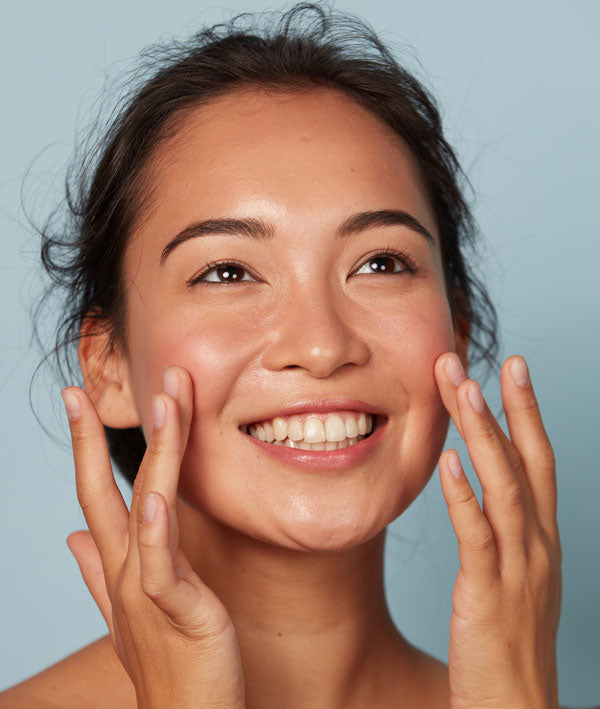Retinol and hyaluronic acid have maintained their status as two of the most buzz-worthy skincare ingredients. But can you use these powerhouses at the same time? We’re breaking down everything you need to know about using hyaluronic acid and retinol in your routine.
Hyaluronic Acid vs Retinol
Hyaluronic acid is a powerful humectant that attracts and retains moisture, leading to hydrated and plump skin. Its ability to bind water molecules helps maintain skin elasticity and reduces the appearance of fine lines. Retinol, a derivative of vitamin A, accelerates skin cell turnover, promoting smoother texture and diminishing wrinkles and hyperpigmentation. However, retinol can sometimes cause dryness or irritation, especially for those new to its use.
Can Hyaluronic Acid & Retinol Be Used Together?
So, can I use hyaluronic acid with retinol?Short answer: yes, retinol and hyaluronic acid together can be a winning combination! One of the most common side effects people experience when using retinol is dryness. By combining it with hyaluronic acid, you’re ensuring the skin is getting extra hydration support to counteract these effects.
Benefits
Integrating hyaluronic acid with retinol can enhance the efficacy of both. The hydrating properties of hyaluronic acid can mitigate the potential drying effects of retinol, making the combination suitable for various skin types, including sensitive skin. This synergy allows for effective anti-aging results without compromising skin hydration.
The Right Way to Use Them Together
The retinol and hyaluronic acid orderapplication can influence the effectiveness of these ingredients. For individuals with normal to oily skin, applying retinol first to clean, dry skin allows it to penetrate deeply. After waiting approximately 10-20 minutes to ensure absorption, a hyaluronic acid serum can be applied to replenish moisture and provide a soothing effect.
For those with dry or sensitive skin, applying hyaluronic acid first can create a buffering layer, reducing potential irritation from retinol. Alternatively, the "sandwich" method—applying a layer of hyaluronic acid, followed by retinol, and then another layer of hyaluronic acid—can offer additional hydration and protection.
Frequency of Use
Introducing retinol gradually is crucial to minimize adverse reactions. Start by applying it once or twice a week, observing how your skin responds. As tolerance builds, frequency can be increased. Hyaluronic acid, being gentle and hydrating, can be used daily, both morning and night.
Additional Tips
-
Moisturizing: Following up with a moisturizer after applying retinol and hyaluronic acid can lock in hydration and further reduce potential dryness.
-
Sun Protection: Retinol increases skin sensitivity to sunlight. Applying a broad-spectrum sunscreen during the day is essential to protect the skin from harmful UV rays.
-
Product Selection: Choose formulations that suit your skin type. For instance, if you have sensitive skin, opt for retinol products with lower concentrations and hyaluronic acid serums free from potential irritants.
Incorporating both hyaluronic acid and retinol into your skincare routine can lead to a more youthful and radiant complexion. By understanding their functions and layering them appropriately, you can maximize their benefits while minimizing potential side effects.
Potential Side Effects & Sensitivities
Hyaluronic acid is a gentle ingredient that has virtually no side effects. That said, some people – especially those with sensitive skin – should patch test their hyaluronic acid product first to ensure they won’t experience any negative reactions.
In addition to causing dryness, retinol can also aggravate the skin – especially when used too frequently or when using a potent formula that your skin hasn’t adjusted to. The key to reducing your risk of experiencing these side effects is to gradually work retinol into your routine. You may start by using it just once a week for a few weeks, and then working up your usage from there (if it seems suitable for your skin). Doing this will allow your skin to adjust to the treatment, minimizing your risk of a negative reaction.
Considerations for Different Skin Types
As mentioned, hyaluronic acid is a super gentle ingredient that is suitable for everyone. The key is finding a high-quality formula that doesn’t contain any additional ingredients that may irritate the skin. This is especially important for sensitive skin types.
The Hyaluronic Pure Boost Serum has a short and sweet ingredient list, allowing the hyaluronic acid to do its best work. This formula is thoughtfully made without fragrances or other irritants, making it a great choice for all skin types.
Retinol, on the other hand, is a bit more complicated, since it can irritate and dry out the skin. As noted above, this means it needs to be used with caution.
When choosing a retinol product, it’s smart to seek out a formula that will work best for your skin type. Someone with dry skin, for example, might look for a low concentration retinol cream to help reduce the drying effects. On the other hand, someone with oily skin may be able to tolerate a more lightweight formula with a higher concentration of retinol.






